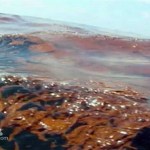chemical dispersants
The second post I wrote for this blog was partly to explain the title:
"Why Speakeasy Science? Well, first because I just wrote a book, The Poisoner's Handbook, which is set in Jazz-Age New York, which was home to some 30,000 speakeasies. Also I like the historical feel of the name. I've always been interested in the intersection of science and culture and I find moments in history, where those two forces pull at each other, to be wonderfully illuminating. Speakeasy itself appeals to my sense of word play - I like the idea of speaking easily about science. And finally - some science…
So, at a Sunday news briefing, British Petroleum's CEO, Tony Hayward, announced that there are no underwater plumes of oil resulting from the April accident at the company's Deepwater Horizon rig in the Gulf of Mexico.
Why? Well, first BP's testing hasn't found any such evidence. And second, Hayward reminds us that, you know, oil floats. Or if we didn't get that: "Oil has a specific gravity that's about half that of water. It wants to get to the surface because of the difference in specific gravity."
Let's give the man this: there is definitely oil floating on the surface…
In a recent discussion on this blog, an interesting thread appeared: the idea that BP's heavy use of chemical dispersants to break up the Gulf oil spill was as much damage cover up as damage control.
Here are a few examples:
My suspicion is that the main reason they used these dispersants was to hide the oil from view.... Anything that will keep the oil out of site below the surface allows them a certain measure of plausible deniability regarding their knowledge of the spills true magnitude.
I think there is a big effort on the part of BP to minimize the aesthetic and…
The latest news from the Gulf of Mexico offers both relief (the "top kill" approach to ending the oil spill may be working) and dismay (the amount of oil pouring into the water is now thought to be closer to 20,000 barrels a day rather than the 5,000 barrels that BP has insisted on for weeks.)
In other words - at worst case - the U.S. Geological Survey estimates that the spill amount may be closer to 39 million gallons of oil so far, rather than the 11 million previously suspected. Now, I've spent the last week or so focusing on the chemical dispersants used to break down the oil,…
tags: Hazmat Dive into the Middle of the Gulf Oil Spill, Corexit, environment, Gulf oil spill, BP, British Petroleum, chemical dispersants, Philippe Cousteau Jr., Sam Champion, television, streaming video
What is the chemical dispersant, Corexit, doing to the oil in the Gulf? This video follows Philippe Cousteau Jr. and Sam Champion as they dive into Gulf's oily waters wearing hazmat uniforms. Their video shows that the oil is being broken up into tiny droplets that coat everything in their path ... birds, fish, whales, boats, the bottom of the sea and people in hazmat suits ... these small…
In the past week, a lot of writers - and, yes, that includes me - have focused on the chemical dispersants being sprayed into the Gulf of Mexico to help manage the ever-expanding oil spill from BP's deepwater drilling rig.
For instance, I recently pointed out while dispersants do help break apart a slick into smaller and more biodegradable fragments, dispersed oil is a great deal more poisonous than crude oil. Further, that post, A Lethal Concentration, generated a great discussion, and one that taught me a lot.
I hadn't considered that the thriving bacterial colonies of warm…
The standard toxicity test for chemical compounds is called the LD50. LD stands for Lethal Dose and 50 indicates 50 percent. In other words, LD50 means the lowest dose at which a material kills half of the test subjects.
The results are usually given in milligrams of compound per kilograms of body weight. Many of these tests are conducted on laboratory rats. To give you a few rat results: the LD50 of table sugar (sucrose) is 29,700 mg/kg. For table salt (sodium chloride, NaCl) it's 3,000 mg/kg. Really poisonous substances, though, measure in the single digits: Sodium cyanide (…

